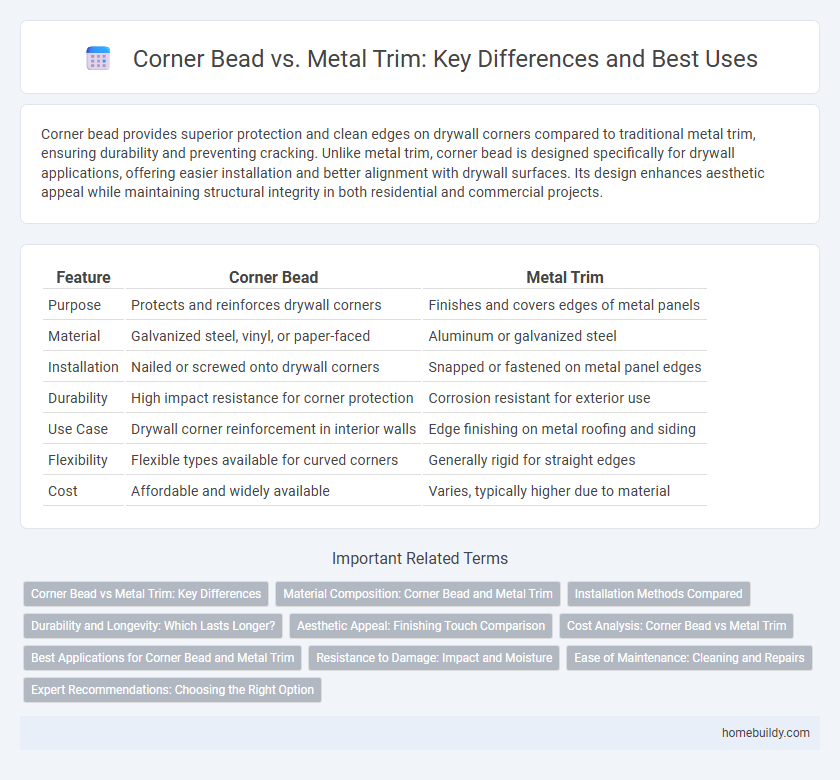Corner bead provides superior protection and clean edges on drywall corners compared to traditional metal trim, ensuring durability and preventing cracking. Unlike metal trim, corner bead is designed specifically for drywall applications, offering easier installation and better alignment with drywall surfaces. Its design enhances aesthetic appeal while maintaining structural integrity in both residential and commercial projects.
Table of Comparison
| Feature | Corner Bead | Metal Trim |
|---|---|---|
| Purpose | Protects and reinforces drywall corners | Finishes and covers edges of metal panels |
| Material | Galvanized steel, vinyl, or paper-faced | Aluminum or galvanized steel |
| Installation | Nailed or screwed onto drywall corners | Snapped or fastened on metal panel edges |
| Durability | High impact resistance for corner protection | Corrosion resistant for exterior use |
| Use Case | Drywall corner reinforcement in interior walls | Edge finishing on metal roofing and siding |
| Flexibility | Flexible types available for curved corners | Generally rigid for straight edges |
| Cost | Affordable and widely available | Varies, typically higher due to material |
Corner Bead vs Metal Trim: Key Differences
Corner bead and metal trim serve distinct purposes in drywall finishing, with corner bead primarily designed to reinforce and protect the drywall corners from damage, offering a smooth and durable edge. Metal trim, on the other hand, acts as a versatile edging solution for various applications including windows, doors, and wall joints, providing structural support and aesthetic appeal. The choice between corner bead and metal trim depends on the specific project requirements such as durability, installation area, and desired finish quality.
Material Composition: Corner Bead and Metal Trim
Corner bead is typically made from galvanized steel, vinyl, or aluminum, providing durability and resistance to rust and corrosion in drywall installations. Metal trim, often composed of steel or aluminum, offers structural reinforcement and a clean edge for various construction applications. The choice between corner bead and metal trim hinges on material flexibility and corrosion resistance specific to the project's environmental conditions.
Installation Methods Compared
Corner bead installation typically involves embedding it into wet joint compound or attaching it with nails or screws, ensuring a seamless, reinforced edge for drywall corners. Metal trim, often used for external cladding or edging, requires fastening with specialized clips, screws, or adhesives, demanding precise alignment to accommodate expansion and contraction. Both materials necessitate surface preparation, but corner bead installation is more forgiving with minor imperfections, while metal trim demands exact measurements for a clean, durable finish.
Durability and Longevity: Which Lasts Longer?
Corner bead typically offers superior durability compared to metal trim due to its corrosion-resistant materials such as PVC or galvanized steel, which withstand moisture and wear over time. Metal trim, often made from aluminum or lighter gauge steel, can be prone to dents, rust, and deformation, reducing its lifespan in high-traffic or humid environments. Choosing corner bead ensures longer-lasting protection and maintains wall integrity, making it a preferred option for long-term durability.
Aesthetic Appeal: Finishing Touch Comparison
Corner beads provide a seamless and smooth finish that enhances the aesthetic appeal of drywall corners, offering clean lines and uniform edges. Metal trims, while durable, often present a more industrial appearance that may not blend as subtly with wall surfaces. The choice between corner bead and metal trim ultimately impacts the visual harmony of interior spaces, with corner beads favored for their refined finishing touch.
Cost Analysis: Corner Bead vs Metal Trim
Corner bead typically offers a more cost-effective solution compared to metal trim due to its lower material and installation expenses. Metal trim, while providing enhanced durability and a sleek finish, often comes with higher upfront costs and requires specialized labor. Evaluating the total project budget, corner bead presents a budget-friendly option for drywall finishing without compromising essential protection and aesthetics.
Best Applications for Corner Bead and Metal Trim
Corner bead is ideal for reinforcing and protecting external drywall corners in residential and commercial construction, providing a smooth, durable edge that resists cracking and damage. Metal trim, often used for finishing edges around windows, doors, and ceilings, excels in applications requiring a sleek, metal edge or weather-resistant exterior finishes. Selecting corner bead is best for interior drywall corners, while metal trim suits exterior or decorative finishing where structural rigidity and aesthetic metal detailing are needed.
Resistance to Damage: Impact and Moisture
Corner bead offers superior resistance to damage from impact and moisture compared to traditional metal trim, making it ideal for high-traffic areas and damp environments. Its durable composite materials prevent dents and corrosion, while metal trim is prone to rust and deformation over time. This enhanced durability extends the lifespan of wall corners and reduces maintenance costs in both residential and commercial applications.
Ease of Maintenance: Cleaning and Repairs
Corner bead offers superior ease of maintenance compared to metal trim due to its durable materials that resist dents and corrosion, reducing the need for frequent repairs. Cleaning corner bead typically requires only simple wiping, as its smooth surface prevents dirt accumulation, unlike metal trim which can trap dust in its grooves. Repairing corner bead is straightforward with patching compounds, whereas metal trim often demands more extensive labor or replacement.
Expert Recommendations: Choosing the Right Option
Experts recommend selecting corner bead for drywall projects that require superior durability and impact resistance, highlighting materials such as vinyl or metal for enhanced protection. Metal trim is preferred for architectural applications demanding a sleek, finished look with added rigidity, often chosen for commercial or industrial settings. Proper installation and material compatibility remain critical factors in ensuring long-lasting performance regardless of the chosen option.
corner bead vs metal trim Infographic

 homebuildy.com
homebuildy.com